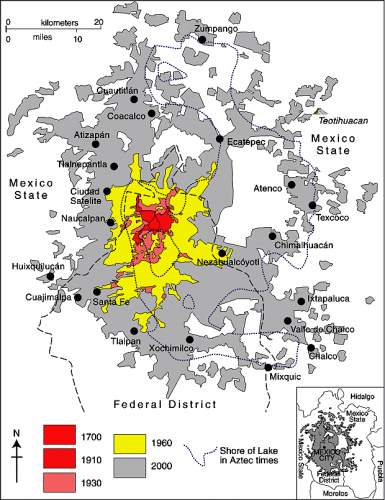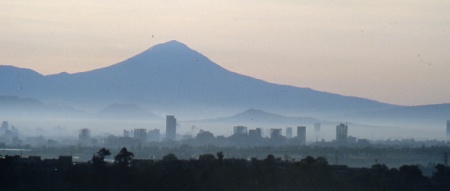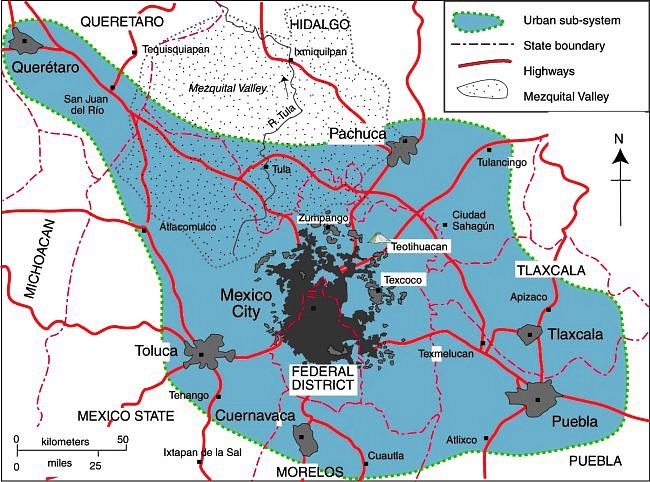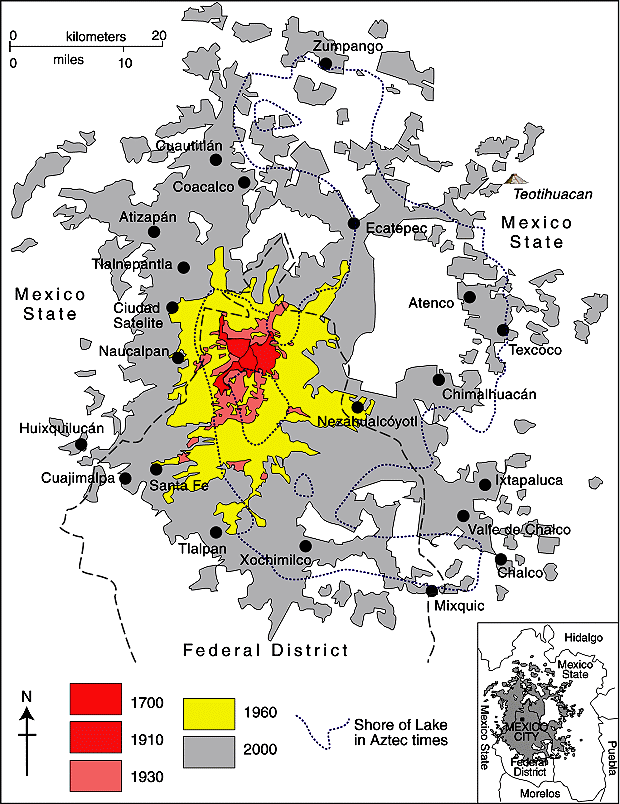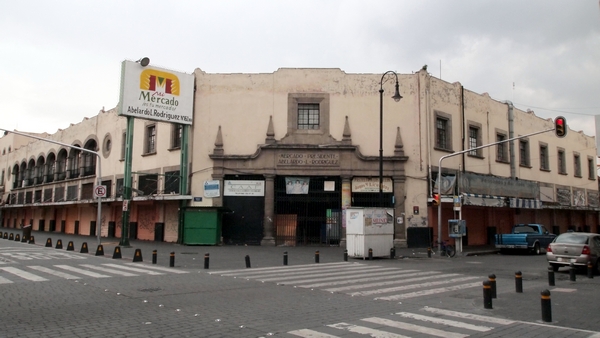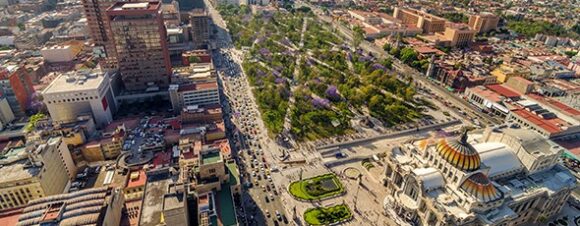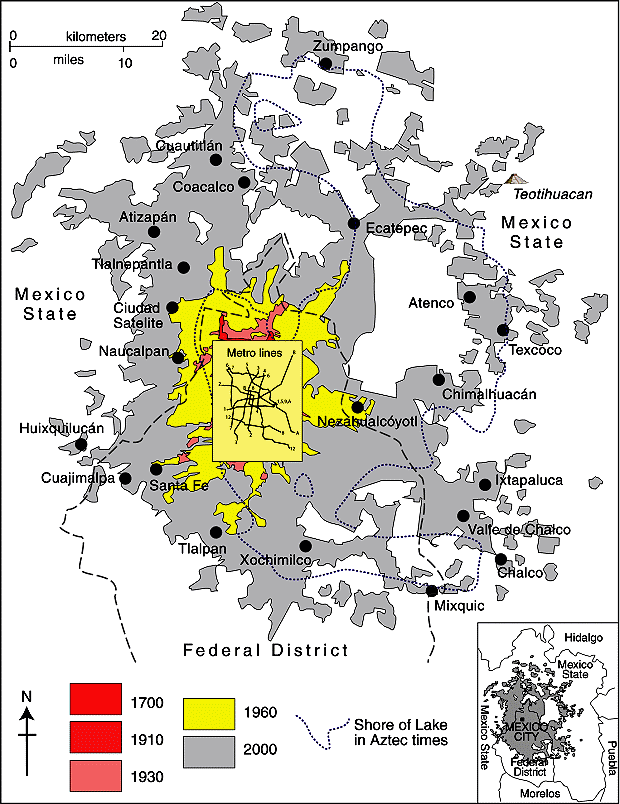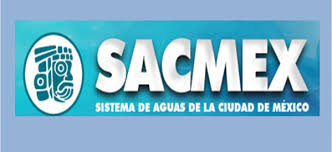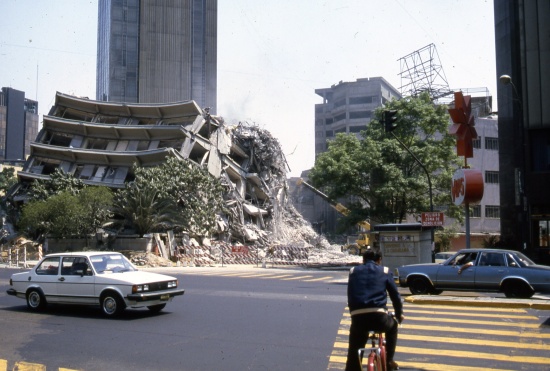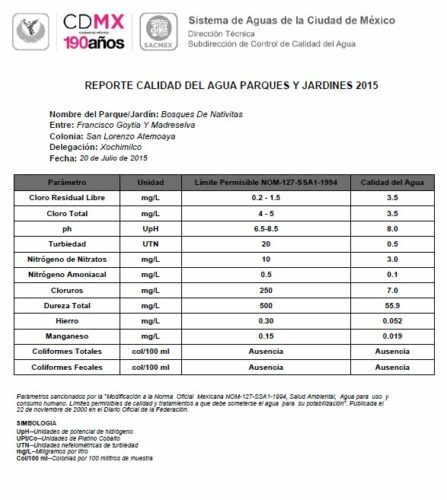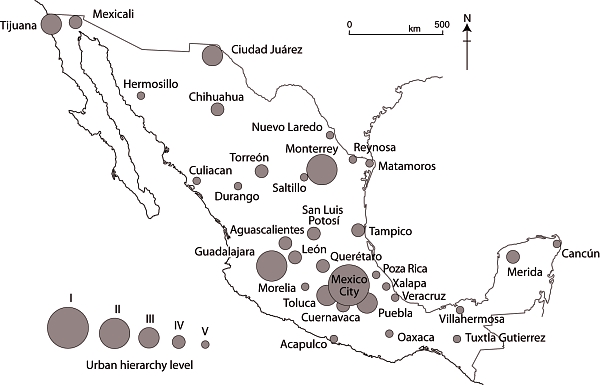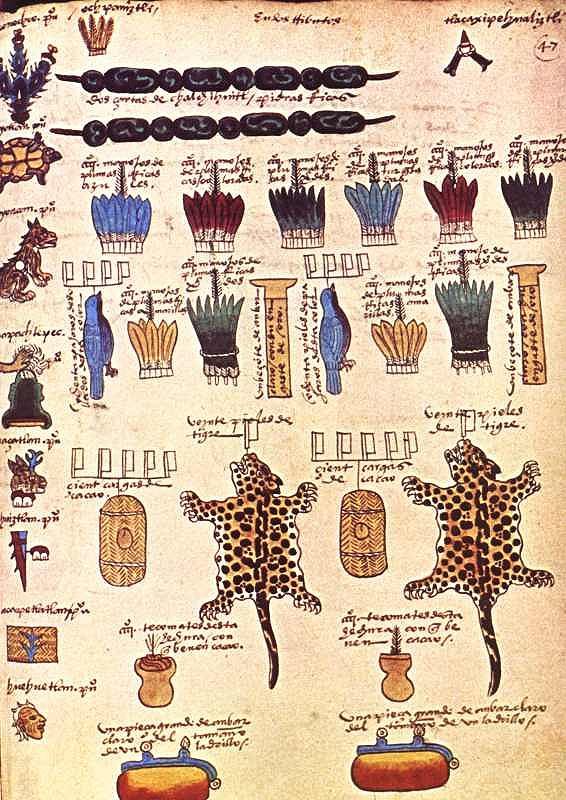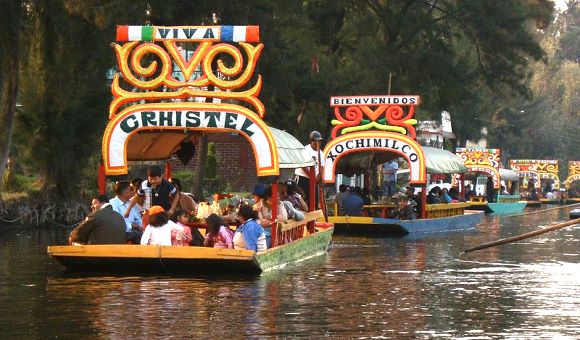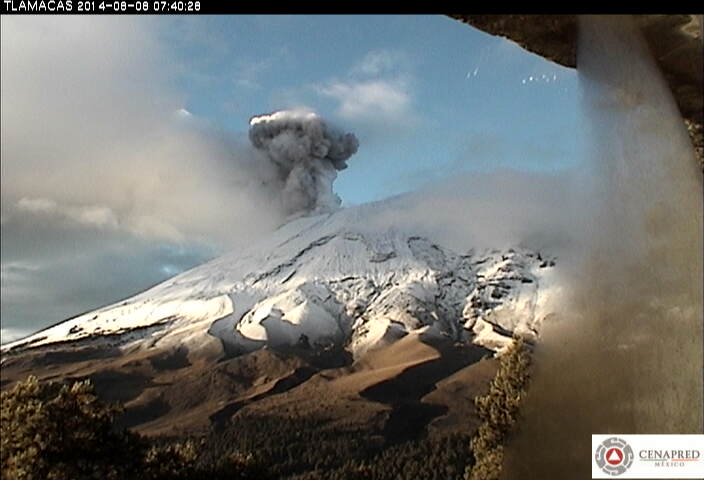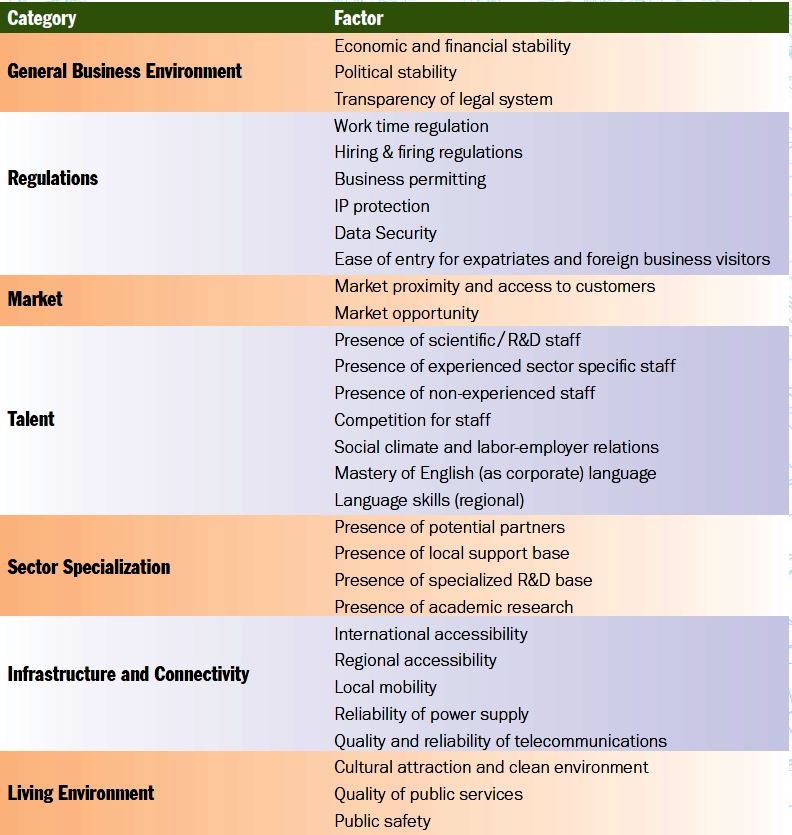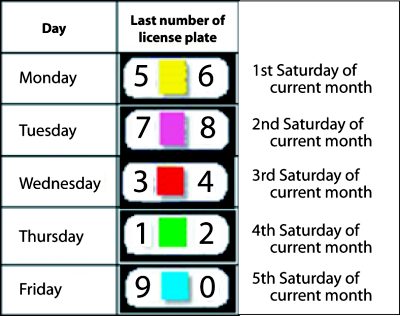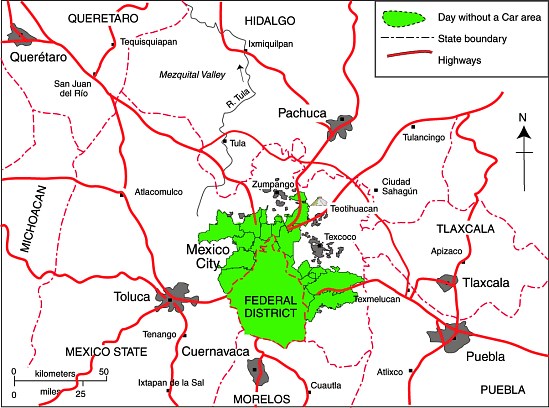Several previous administrations have tried to decentralize Mexico, encouraging businesses to set up in the “periphery” away from the “core” of Mexico City and central Mexico. The incoming administration has announced its intention to move several federal government Secretariats away from Mexico City. The plans are discussed in some detail in this interesting article by Simon Schatzberg:
Mexico City subsidence and the metro system
Katherine Kornei has just published an interesting account of the recent effects in Mexico City of ground subsidence on the city’s metro system:
Amazing what is possible using satellite technology!
In 2009 Feike de Jong walked the entire perimeter of Mexico City to capture the strange scenery of its fringes. The 800-km trek took him 51 days.
These two Guardian articles tell the story of his trip:
- Cockfights in the edgelands: the man who walked Mexico City’s perimeter
- The very edge of a city: Mexico City’s deepest hinterlands – in pictures
The author’s ebook Limits: On Foot Along the Edge of the Megalopolis of the Valley of Mexico, with the full story and more images, is due to be released later this year.
Enjoy!
Want to learn more about Mexico City?
The geography of Mexico City: index page
This index page has links to our more important posts about Mexico City. Other index pages include:
- Mexican migrants and remittances: an introduction (last update Jun 2016)
- Maps of Mexico on geo-mexico.com (Nov 2015)
- The geography of Mexican farming, agriculture and food production (Jun 2015)
- The geography of Mexico’s drug trade (Sep 2016).
- Mexico’s Indigenous Peoples: an index page (4 Aug 2016)
- Tourism index page (28 Sep 2015)
- The geography of Chiapas (20 Aug 2015)
- 30 top geotourism sites in Mexico (Geo-Mexico special) (May 2015)
Administrative
- Federal District is renamed Mexico City (Feb 2016)
Mexico City background / physical geography / hazards
- The 1985 Mexico City earthquakes: a major disaster (Jul 2011)
- Popocatepetl Volcano puts on an explosive show (Jul 2013)
- Why are some parts of Mexico City sinking into the old lakebed? (Nov 2010)
- How fast is the ground sinking in Mexico City and what can be done about it? (Apr 2012)
- More ground cracks appearing in Mexico City and the Valley of Mexico
- Subsidence incident leads to demolition of 31 homes in the State of Mexico
- Ground subsidence in Mexico City threatens 10,000 homes (Feb 2015)
- The urgent need for reforestation of hills near Mexico City (Jan 2012)
- More problems for residents of Valle de Chalco on the south-eastern edge of Mexico City (May 2011)
Water supply / drainage
- Where does Mexico City get its water from? {May 2013)
- How can Mexico City find sufficient water? (May 2013)
- Mexico City explores deep water aquifer (Dec 2013)
- Test wells being drilled to assess Mexico City’s deep water aquifer (Sep 2014)
- More water meters for Mexico City (Oct 2015)
- Mexico City’s Drinking Water Fountains (Aug 2015
Sewers / Drainage
- Attempts to provide drainage for Mexico City date back to Aztec times (Apr 2011)
- Maintaining the drains and sewers of Mexico City (Jan 2012)
- Mexico D.F. administration offers amnesty to illegal water users (Jul 2011)
- The Eastern Drainage Tunnel: a solution to Mexico City’s drainage problems? (Jan 2012)
Aztecs – Food supply
History / Urban growth / Urban morphology / Housing
- Mexico City in colonial times: 1530–1820
- Battle of Puebla re-enacted each year on Cinco de Mayo (May 5), but in Mexico City
- Quick photo visit to Mexico City (Aug 2014)
- Street patterns in Mexico City
- Santa Fe, a case study of a real estate development on Mexico City’s periphery
- A case study of low-income housing on the urban periphery
- Vecindades, Mexico City’s inner-city slums (Jul 2010)
- Nezahualcoyotl, an irregular settlement which grew into a monster (Jul 2010)
- Informal settlements or “colonias populares” in Mexico’s cities
- Great new site about Mexico City’s Historic Center, but map misses the mark (Jul 2012)
- Micro-businesses help improve the economic and social outlook for irregular settlements (Apr 2011)
- Author David Lida on Mexico City’s transportation systems (Apr 2015)
- Historic photo of the month: Mexico City cave-dwellers (Jul 2015)
- Mexico City chosen over Curitiba (Brazil) as World Design Capital 2018 (Feb 2016)
Megalopolis?
Traffic, taxis and air pollution
- Plans to improve the Mexico City-Toluca transport corridor (Jan 2014)
- Mexico City tackles the challenges of population, commuting and air quality (Aug 2012)
- Traffic congestion still a serious problem for commuters in Mexico City (Sep 2011)
- Mexico City’s “Today you can’t drive” (Day without a Car) program, “Hoy no circula” (Nov 2013)
- Mexico City traffic: short video highlights on-going improvements (Jul 2012)
- Air quality improving in Mexico City but not in Monterrey (Aug 2010)
Metro/subway system
- Mexico City looks to expand its metro network (Dec 2014)
- Line 12, Mexico City’s latest Metro (subway) line (Jan 2103)
- The challenge of building and maintaining Mexico City’s metro system [Nov 2010]
Sustainable Transport / Cable Cars
- New aerial transit system proposed for Mexico City (Sep 2013)
- Will Mexico City add cable cars to its mass transit system? (Apr 2013)
- Passenger cable car for Mexico City (Jan 2014)
- Mexico City wins 2013 Sustainable Transport Award (Jan 2013)
- Mexico City’s Ecobici cycle rental system enters its second year (Feb 2011)
- Mexico City’s Ecobici cycle rental system enters its fifth year (Feb 2014)
Airport
- A new airport for Mexico City (Sep 2014)
Urban revitalization
- The on-going transformation of Mexico City [May 2011]
- The revitalization of Mexico City’s historic downtown core [Aug 2010]
Other
- Recycled plastic boats for Xochimilco? (Oct 2014)
- Mexico City’s wholesale food market, Central de Abasto (Jul 2010)
- Bringing place names to life in Mexico City (Aug 2010)
- Mexico City has largely escaped drug violence (Mar 2012)
- Updates on the geography of Mexico City (Mar 2011)
- Updates on the geography of Mexico City (Dec 2010)
- Recent news briefs related to the geography of Mexico City (Oct 2010)
Map of Mexico City urban system:
Spatial growth of Mexico City Metropolitan Area:
Locations in Valley of Mexico with high incidence of ground cracks:
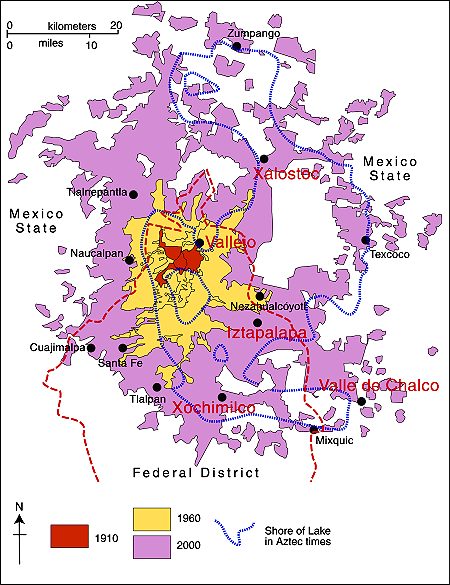
Locations in Valley of Mexico with high incidence of ground cracks. Cartography: Tony Burton; all rights reserved.
General posts about Mexico’s urban geography
- Mexico’s urban hierarchy (May 2015)
- The distinctive sounds of Mexico’s towns and cities (Aug 2010)
- Are Mexico’s large cities growing faster than small cities? (Jun 2011)
- Have big cities in Mexico succeeded in meeting people’s needs? (Sep 2013)
- Mexico’s urban air pollution remains the worst in Latin America (Aug 2013)
- Several Mexican cities rank among the American Cities of the Future (Apr 2013)
- What is the elevation of Mexico’s cities? (Feb 2013)
- The changing climate of Mexico’s urban areas (Dec 2011)
- Mexico’s major metropolitan areas and cities, 2010
- The impact of NAFTA on urban growth in Mexico (Jun 2010)
Mexico City declares public markets to be Intangible Cultural Heritage
Mexico has some of the finest markets in the world. The variety of produce and other items sold in markets is staggering. But not all Mexican markets are the same. The two major groups are the permanent markets (mercados), usually housed in a purpose-built structure and open for business every day, and the street market or tianguis, usually held once a week.
Earlier this month, Mexico City passed legislation that gave the city’s 329 public markets Intangible Cultural Heritage status, and provided additional funding to ensure that their traditional activities are maintained for future generations.
Some of the markets are traditional, mixed markets, others are specialized. Between them, they are used on a regular basis by almost half of Mexico City’s residents and provide more than 280,000 jobs. The Mexico City commission established to preserve these traditional spaces and their practices has been allocated a budget in 2017 of $200,000,000 pesos (about $11 million).
Beyond their regular role as a trading place, many of the markets in Mexico City have additional claims to fame. For example the La Paz market in Tlalpan in the southern part of the city occupies an architecturally impressive building, while the Abelardo L. Rodríguez market in the downtown area has fine decorative murals painted by students of Diego Rivera.
Related posts:
Mexico City chosen over Curitiba (Brazil) as World Design Capital 2018
At its 29th General Assembly in Gwangju, South Korea, a few months ago, the International Council of Societies of Industrial Design (ICSID) announced that Mexico City has been designated World Design Capital (WDC) 2018. Mexico City is the first city from the Americas to hold the designation.
ICSID President Professor Mugendi M’Rithaa stated, “Mexico City will serve as a model for other megacities around the world grappling with the challenges of urbanization and using design thinking to ensure a safer, more livable city.”
The WDC is awarded every second year to cities that are committed to using design as an effective tool for economic, social, and cultural development. Previous designated cities include Torino (Italy) in 2008, Seoul (South Korea) in 2010, Helsinki (Finland) in 2012, Cape Town (South Africa) in 2014, and Taipei this year, 2016.
The bid was led by Design Week Mexico, a non-profit organization that promotes design as an engine of social change. Design Week Mexico intends to focus its actions on the borough of Miguel Hidalgo, introducing new health, communications and security programs, a bike sharing program, urban gardens, parks and playgrounds. Emilio Cabrera, Director General of Design Week Mexico said, “Our goal is to build a platform for collaboration not only between design disciplines, but also between countries. As WDC, we seek to create a hub of global creative industries that have an impact on their societies.”
The Mexico City bid was preferred over a rival bid from Curitiba (Brazil), well known for its innovative approach to urban sustainability.
For access to more than sixty articles about all aspects of the geography of Mexico City, see The geography of Mexico City: index page.
Related posts:
- The challenge of building and maintaining Mexico City’s metro system
- Mexico City tackles the challenges of population, commuting and air quality [Aug 2012]
- Mexico City wins 2013 Sustainable Transport Award[Jan 2013]
- How can Mexico City find sufficient water? (May 2013)
- Thirty years ago: the 1985 Mexico City earthquakes, a major disaster
- Historic photo of the month: Mexico City cave-dwellers
Federal District is renamed Mexico City
The name “Distrito Federal” (Federal District) has been replaced by “Ciudad de México” (Mexico City). This is bad news for cartographers who need to relabel all those maps that say “Mexico D.F.”! The abbreviated form for the city’s name in Spanish will be CDMX.
The constitution for the new administrative entity, which will eventually enjoy full status as a state, will be drawn up by a group of 100 citizens (to be elected in June), expected to include some members of the federal Chamber of Deputies.
Among other advantages, the change of status means that Mexico City will no longer need federal approval when selecting its police chief and attorney general. Administration of Mexico City’s 16 delegaciones (boroughs) will change from borough chiefs and regidores to mayors and councils.
Mexico City will remain Mexico’s capital city and the seat of the federal administration. No changes are planned for the neighboring Estado de México (State of Mexico). The Mexico City Metropolitan Area (MCMA) includes Mexico City, but also extends well into adjacent areas of the State of Mexico.
Want to learn more?
For access to more than sixty articles about all aspects of the geography of Mexico City, see The geography of Mexico City: index page.
Line 12 of Mexico City’s Metro (subway) system was originally opened in October 2012. The new line, also known as the Golden Line, extended the city’s metro system into several lower income areas in the south-eastern part of the city, including Tlahuac, Milpa Alta, Xochimilco and Iztapalapa.
However, in March 2014, the elevated (above ground) 14-kilometer-long (9 mi) southern section of this line between Tlahuac and Atlalilco stations was closed for emergency repairs. A replacement bus system was established between those stations. According to a report in the Mexico City daily Reforma (citing a study by ILF Consulting Engineers), the design of tracks in that section had resulted in damage to the wheels of several metro trains. It also resulted in the failure of an electric cable and caused cracks and fractures in the track supports. Authorities have blamed some former city officials, together with the line’s builders, a consortium comprised of France’s Alstom and the Mexican companies ICA and Carso.
Metro Line 12 was finally fully reopened 20 months later, on 29 November, 2015. Line 12 is the longest line in the city’s metro network,extending 25 km (15.5 miles), with 20 stations, including four transfer points. In terms of network connectivity, it added an important east-west link connecting four lines that serve the southern section of the metro area. Line 12 runs from Mixcoac (Line 7) to Tlahuac in the southeast of Mexico City, intersecting with line 3 at Zapata, line 2 at Ermita and line 8 at Atlalilco.
 Officials estimate that the line, which has both underground and overground sections, eliminates 860 buses from the city’s congested streets, reducing carbon dioxide emissions by 22,000 metric tons a year. It cost about $1.8 billion to construct.
Officials estimate that the line, which has both underground and overground sections, eliminates 860 buses from the city’s congested streets, reducing carbon dioxide emissions by 22,000 metric tons a year. It cost about $1.8 billion to construct.
 Between 400,000 and 450,000 passengers are now expected to use Line 12 daily. It is expected to cut the average daily commuting time from those parts of the city it serves by more than an hour a day, from 150 minutes to 78 minutes. The line is only accessible by using the new metropolitan smart transport card “Tarjeta DF”.
Between 400,000 and 450,000 passengers are now expected to use Line 12 daily. It is expected to cut the average daily commuting time from those parts of the city it serves by more than an hour a day, from 150 minutes to 78 minutes. The line is only accessible by using the new metropolitan smart transport card “Tarjeta DF”.
The complete network of 12 lines comprising Mexico City’s metro system, used by more than 5 million passengers a day, now has 195 stations and a total length of about 227 km (141 miles).
Will the line eventually be extended?
In January 2013, officials of Mexico City’s Metro system (Sistema de Transporte Colectivo, STC) announced that they were considering extending Line 12 westwards into the Álvaro Obregón district of the city. This is still being talked about. STC’s Managing Director Joel Ortega Cuevas also said that an analysis was needed of the viability of extending the Metro network to reach several major commuting routes in the State of México (see map), including Ecatepec-Coacalco-Zumpango; Chalco-Ixtapaluca; Naucalpan-Tlalnepantla-Cuautitlán; Atizapan-Naucalpan and Chimalhuacan-Nezahualcóyotl.
Useful links:
- Map of Mexico City metro system, including Line 12 (png image file)
- Map of Mexico City metro system (official printable system map, pdf file)
Related posts:
- The challenge of building and maintaining Mexico City’s metro system
- Why are some parts of Mexico City sinking into the old lakebed?
- How fast is the ground sinking in Mexico City and what can be done about it?
- Traffic congestion still a serious problem for commuters in Mexico City [Sep 2011]
- Mexico City tackles the challenges of population, commuting and air quality [Aug 2012]
- Mexico City wins 2013 Sustainable Transport Award[Jan 2013]
More water meters for Mexico City
A recent OOSKAnews report says that Mexico City’s water authority (Sacmex) is seeking to purchase 27,835 more water meters that it plans to install in coming months. Sacmex supplies water to around 2 million separate addresses, of which 1.4 million are already metered. The latest purchase is part of Sacmex’s plan to ensure that 100% of connections to the water system are metered. Sacmex’s current budget includes $3.5 million for an additional 40,000 meters.
At present, users without a meter pay a fixed bi-monthly tariff based on the building category, and intended type of water use (domestic/industrial/commercial).
Funding for the meters will be part of a $200 million World Bank-supported “Program to Improve the Efficiency of Operating Organizations” (PROME) which has already financed various projects across the country for urban areas with populations over 20,000. Projects already funded by the Progam include more efficient pumps, the updating of user databases with geo-referencing technology, and studies to gauge the robustness of indicators such as water pressure, water quality and leak detection.
Sacmex is also working on other distribution issues. Earlier this year – see Water in Mexico: a human right that is currently subsidized and wasted – Sacmex CEO Ramón Aguirre Diaz said that the agency required $430 million to combat leakages in the system (currently estimated at around 40% of supply), and claimed that a long-term program to fix the problem would be introduced next year.
Related posts:
- Where does Mexico City get its water? (May 2013)
- How can Mexico City find sufficient water? (May 2013)
- Test wells being drilled to assess Mexico City’s deep water aquifer
- Mexico City’s Drinking Water Fountains (Aug 2015)
- Mexico D.F. administration offers amnesty to illegal water users
- Which cities have the best and worst water systems in Mexico?
- Mexico’s major cities confront serious water supply issues
Thirty years ago: the 1985 Mexico City earthquakes, a major disaster
The worst earthquake disaster in modern Mexican history occurred thirty years ago this week. On Thursday 19 September 1985 a magnitude 8.1 earthquake struck at 7:19 a.m. and lasted a full two minutes. It was followed by a 7.5-magnitude earthquake 36 hours later.
These earthquakes resulted from the Cocos Plate (see map) pushing under the North American Plate. While the epicenters were 50 km off Mexico’s Pacific coast, near the Michoacán-Guerrero border, most of the damage occurred 350 km (215 mi) away in Mexico City because the city center’s subsoil, being former lakebed, is very unstable. The clay and silt beneath the city is up to 50 m thick in the area that received most damage. Geologists have likened the effects of the earthquake to the shaking of a bowl of jelly.
Further damage was caused by liquefaction, a process in which water is squeezed rapidly through the pore spaces in soil, dramatically reducing its cohesion. The sediments beneath Mexico City amplified the ground motions during the earthquakes and many buildings were stressed well beyond building code limits.
Damage estimates range upward to 10,000 deaths, 50,000 injured and 100,000 homeless. More than 500 buildings collapsed, and a further 600 of the 3000 damaged structures were subsequently razed to the ground. The destruction was concentrated in a relatively small area near the city center and included many public buildings, such as government offices, as well as 11 hospitals and clinics, numerous multi-story apartment blocks, 11 hotels and 10 banks. More than 1600 school classrooms were damaged.
Buildings of between 6 and 15 stories were especially hard hit. The underbelly of the city was exposed; dozens of textile sweatshops were destroyed. The damages revealed many instances of poor construction standards and of poor enforcement of building codes. Well-built high rises such as the Latin American tower, designed to be earthquake-proof, were unscathed.
The total cost to the Mexican economy was estimated to exceed $5 billion, equivalent to 2% of the country’s GDP (Gross Domestic Product).
The disastrous 1985 earthquakes led to much tighter building codes, equal or superior to anywhere in the world, and to the formation of well-trained emergency search and rescue brigades. They also resulted in the establishment of a Seismic Alarm System which provides a 50-second warning for any earthquake measuring over 6.0 on the Richter scale occurring off the coast of Guerrero or Michoacán.
This is an excerpt from chapter 2 of Geo-Mexico: the geography and dynamics of modern Mexico. Many more details of Mexico’s geology and landforms are analyzed in other parts of the book; take a look using Amazon.com’s Look Inside feature before buying your copy today!
Related posts:
- Which tectonic plates affect Mexico?
- How has the movement of tectonic plates affected Mexico?
- Major earthquake strikes Guerrero and Oaxaca states (20 Mar 2011)
- Two major earthquakes jolted western Mexico (11/12 Apr 2012)
- 7.2 earthquake in Guerrero shakes Mexico City and central Mexico (18 Apr 2014)
- 6.9 magnitude earthquake strikes Chiapas and Guatemala (7 Jul 2014)
- Was this fissure near Hermosillo caused by subsidence or by faulting?
Water in Mexico: a human right that is currently subsidized and wasted
Two recent articles in OOSKAnews, a publication dedicated to news in the water industry, have profound implications for Mexico’s water supply situation. The first (10 July 2015) is a report of a meeting in Guanajuato of national water and water treatment specialists (Segundo Encuentro Nacional de Áreas Técnicas de las Empresas de Agua y Saneamiento de México).
Selected quotes from the report include,
Mexico’s legal framework for water is out of date and does not reflect the country’s current reality…
Nationwide, water users only pay about 20% of the cost of production; 80% of water costs are subsidized, a situation that is not sustainable…
Legal reforms aimed at protecting human rights with regard to water had harmed service providers, who cannot cut off service to customers who fail to pay their bills.”
The report also comments on the on-going El Zapotillo dam project on the Rio Verde in Jalisco state, saying that it,
is a priority for President Enrique Pena Nieto’s administration, despite ongoing delays and legal conflicts. The $1.24 billion dollar project was approved in 2005 and is more than 80% complete. However, residents of Temacapulín, Acasico and Palmarejo have been fighting construction of the dam, which would flood their villages.”
The second report focuses on Mexico City and the estimate by Ramón Aguirre Díaz, the head of Mexico City’s Water System (SACMEX), that fixing leaks in the city’s potable water distribution network would cost around US$430 million. This is a huge cost when compared to the system’s annual budget for maintenance and improvement of infrastructure of about US$135 million.
Aguirre claims that 40% of available water is lost because of leaks in the network. SACMEX is launching a program in 2016 to provide a long-term solution to the problem. In a press interview, the official said that, “A city like ours should be able to supply every citizen by producing 26 cubic meters/second, but currently our system requires 30.5 cubic meters/second”.
The sections of the city with the most severe losses are those like Coyoacán and Tlalpan built on the soft sediments of the former lake-bed, as well as those such as Miguel Hidalgo, Cuauhtémoc, and Benito Juárez, where the supply pipes are more than 70 years old. Combined, these areas house over 2.5 million people.
Aguirre also outlined the progress made in bringing reliable access to potable water to all 1.8 million inhabitants of Iztapalapa, one of the poorest and most densely populated sections of the city. Some 72,000 residents in Iztapalapa lack piped water supply to their homes, and therefore have to depend on provision from tanker trucks. Even those who do have access to piped water have to cope with inadequate pressure, poor water quality and frequent supply outages.
According to Aguirre, the city administration will meet its goal of reliable access to piped water for all of Iztapalapa by 2018. Reaching this point requires the construction of 22 water treatment plants and various other major infrastructure modernization projects.
Related posts:
- Mexico’s freshwater aquifers: undervalued and overexploited (Nov 2011)
- How can Mexico City find sufficient water? (May 2013)
- How does Mexico’s water footprint compare to that of other countries?
- Access to safe water is a human right in Mexico (Dec 2014)
- Test wells being drilled to assess Mexico City’s deep water aquifer
- Mexicans drink more bottled water per person than anywhere else in the world
Mexico City’s Drinking Water Fountains
Earlier this summer, Mexico City’s Water System (SACMEX) inaugurated a network of 230 drinking fountains installed in public spaces across the city. The fountains are part of the city’s initiative to curb reliance on bottled water. (Mexicans consume more bottled water per person than any other country in the world).

Click for interactive map of Mexico City water fountains
The sites for the fountains were selected taking local water quality into account. An interactive website enables residents and visitors alike to find the locations of the fountains, and offers up-to-date information about the water quality parameters.
Water from all the fountains is being tested on a regular basis to ensure that it complies fully with official water quality standards.
Related posts:
- Mexico’s freshwater aquifers: undervalued and overexploited (Nov 2011)
- How can Mexico City find sufficient water? (May 2013)
- How does Mexico’s water footprint compare to that of other countries?
- The pros and cons of bottled water (May 2010)
- Access to safe water is a human right in Mexico (Dec 2014)
- Test wells being drilled to assess Mexico City’s deep water aquifer
- Recent progress in waste water treatment in Mexico (Aug 2014)
- Mexicans drink more bottled water per person than anywhere else in the world
Historic photo of the month: Mexico City cave-dwellers
A shout out to Marcia Ambler for sharing, via email, her memories of Mexico City in the 1950s. Among other things, she recalled how she lived as a child with her family, “in a suburb of Mexico City, where there was a deep barranca with people who lived as cliff dwellers in the barranca walls. There was also a cave nearby with a deep drop which I went in with my friends.”
Her email brought back some fond personal memories of Mexico City from the late 1970s and early 1980s. Shortly after I moved to the city, Time Life published The Great Cities: Mexico City, by John Cottrell. I found this book fascinating at the time, and a quick re-read earlier this week confirms that it still well worth looking for (inexpensive copies available via Abebooks) if you are interested in what makes one of the world’s largest cities tick.
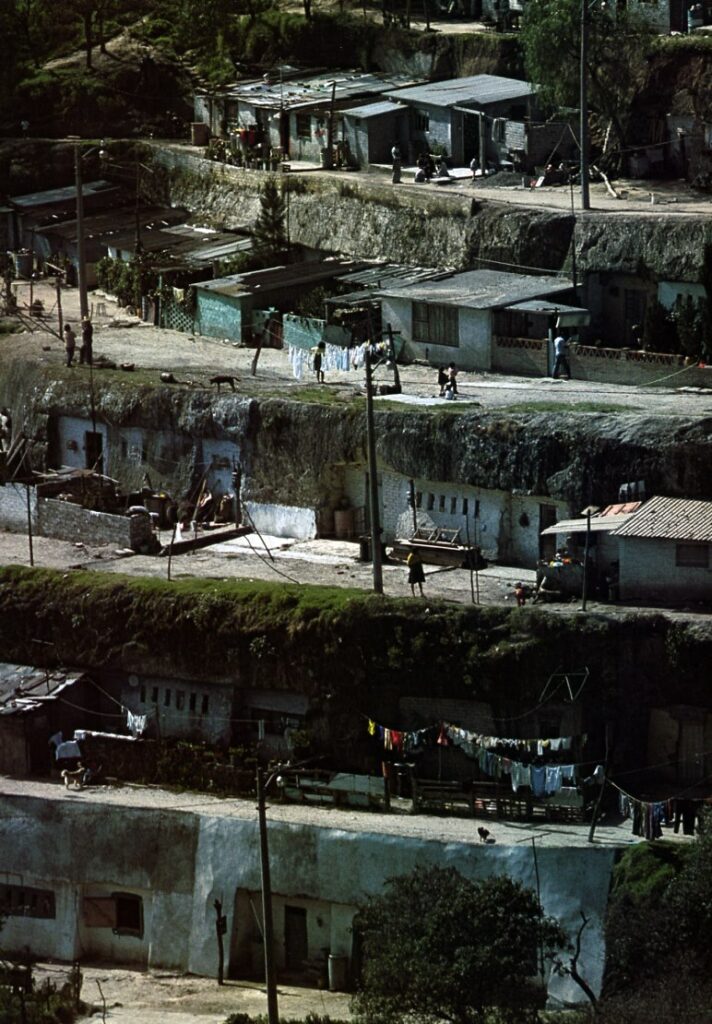
Mexico City cave dwellers. Photo by Harold Sund in “The Great Cities: Mexico City” (Time Life, 1979).
Like most Time Life books, it is lavishly illustrated, which brings me back to the caves and cave dwellers, since one of the photos (above), by Harold Sund shows the area that Marcia remembers, and which was also my first introduction to the curious world of relatively modern-day troglodytes in Mexico City.
Sund’s photo shows the Belén de las Flores community, relatively close to western end of Chapultepec Park, though there may well have been, and almost certainly were, several similar settlements elsewhere. This short newspaper article, from the Bangor Daily News in 1978, describes the “year-round comfort” that can be enjoyed in such caves.
I haven’t had the opportunity to revisit this area of Mexico City for more than thirty years, so I’m anxious to know what it looks like now.
Sincere thanks, Marcia, for your message which certainly took me on a trip down memory lane!
Source of photo:
- John Cottrell. 1979. The Great Cities: Mexico City (Time Life Books, 1979). Photography by Harold Sund.
Related posts:
- The geography of Mexico City: index page
- Santa Fe, a case study of a real estate development on Mexico City’s periphery
- A case study of low-income housing on the urban periphery
- Vecindades, Mexico City’s inner-city slums (Jul 2010)
- Nezahualcoyotl, an irregular settlement which grew into a monster (Jul 2010)
- Informal settlements or “colonias populares” in Mexico’s cities
Mexico’s urban hierarchy
Mexico’s urban hierarchy is still very dominated by Mexico City, its primate capital city. Even though the Mexico City urban area (ZMCM) has grown relatively slowly during the past 30 years, by 2000 it had a population of 17.8 million, almost five times larger than Guadalajara, instead of twice as large as expected from the rank size rule.
The concept of urban hierarchy is more complicated than the rank-size rule, which is based solely on population size. Urban hierarchy is based more on the functions provided by urban centers and their relationships with their hinterlands. An urban hierarchy is conceptually similar to an organization chart or layered pyramid. At the top is the largest center, the dominant financial, economic, and often political center of the country. It has the widest range and most complex set of urban functions and services such as international banking, stock exchanges, trade organizations, and major media and communications centers. It is the center of power of the country: the place where the most important decisions are made.
At the second level are a few regional cities that are the centers of power in their region or hinterland. They provide high level services that are not available elsewhere in the region. Such services might include investment banking, an important international airport, as well as sophisticated business, legal and medical centers. At the third level are a larger number of subregional centers which are the focus of economic activity in their subregion. At each succeeding lower level, there are a greater number of centers serving as the economic foci of their smaller hinterlands.
Often a center’s population is a guide to its level in the hierarchy, but not always. Some centers may have a large population, but do not provide a wide range of key economic functions to surrounding areas. For example, Puebla is Mexico’s fourth largest urban area, but does not serve as a real center for a national region because it is so close to Mexico City. In other words, Mexico City is so economically dominant in central Mexico that Puebla has been unable to carve out a substantial hinterland of its own. The same can be said for Toluca, Mexico’s fifth largest urban area.
Tourist centers like Cancún and Acapulco are other examples of cities that have a reduced regional importance despite their relatively large populations. They provide vacation and recreation services for visitors from around the world. However, neither is a state capital, and they are not necessarily the key functional center in their respective regions.
Given their complexity, the specific delineation of urban hierarchies has often been as much art as science. So far, no uniformly accepted, easy to use criteria have been developed for this purpose. Efforts to delineate urban hierarchies have traditionally used information on the range of services provided; financial, communication and transportation flows; as well as a center’s location, its surrounding hinterland, and the distance to competing centers.
Mexico City is at the apex on the Mexican urban hierarchy; Guadalajara and Monterrey are key second level cities. Beyond these three centers, there is less agreement concerning the appropriate levels of other urban centers. Some think there are only two genuine level two cities, while others have argued that Toluca, Tijuana and Ciudad Juárez should also be considered level two cities. There is even less agreement when it comes to specifying cities in levels three and four. The exact delineation of the levels is less important than understanding the basic concepts of urban hierarchy and realizing that a city’s level is related to the range of functions it provides to its surrounding hinterland.
The suggested current urban hierarchy of Mexico (see map) is based on objective and subjective information on the urban center itself, as well as the population in its hinterland and its distance from a competing urban center. This hierarchy is only suggestive. Intermediate levels could be added indicating centers that could arguably be included in either the level above or level below.
The current hierarchy is not static and is very different from the urban system of the Colonial era, or even of the 19th century. The one constant is that Mexico City has always been at the apex of the hierarchy. The positions of individual cities may change drastically with changing economic and political conditions. For example, Guanajuato was once an important level two city, but with the decline of its silver mines, it dropped below level five.
Related posts:
- The geography of Mexico City: index page
- Are Mexico’s large cities growing faster than small cities? (Jun 2011)
- Several Mexican cities rank among the American Cities of the Future (Apr 2013)
- What is the elevation of Mexico’s cities? (Feb 2013)
- The changing climate of Mexico’s urban areas (Dec 2011)
- Mexico’s major metropolitan areas and cities, 2010
Author David Lida on Mexico City’s transportation systems
David Lida is a well-known and highly respected author who has lived in Mexico City (on and off) for over twenty years. His books include First Stop in the New World: Mexico City, Capital of the 21st Century and the short-story collection Travel Advisory: Stories of Mexico. He also blogs about Mexico City:
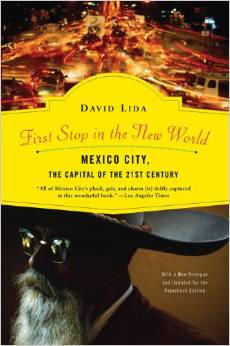 His article a few months back in the Guardian about life in Mexico City – An urbanist’s guide to Mexico City: ‘Transport is an adventure and often a nightmare” – is an informative account of his love-hate relationship with the city. The following short extracts from his article, relating to the geography of the city, should sharpen your appetite to read more:
His article a few months back in the Guardian about life in Mexico City – An urbanist’s guide to Mexico City: ‘Transport is an adventure and often a nightmare” – is an informative account of his love-hate relationship with the city. The following short extracts from his article, relating to the geography of the city, should sharpen your appetite to read more:
“The greater metropolitan area of Mexico City is home to about 22 million people (known as chilangos) and is laid out over about 600 square miles…. The most recent study, from 2007, says that it takes chilangos an average of an hour and 17 minutes to get from one place to another.”
“Half of the working population toils in the informal economy – parking cars, cleaning houses, packing groceries, selling things on the street. The middle class is squeezed month by month rather than daily, while perhaps 10% has a jolly time with plenty of discretionary income. According to Forbes, Mexico’s elite upper class is made up of 1.7% of the population.”
“Although it is not comprehensive, and the stations are spaced further apart than they are in some other places, if your destination is on the route the metro is the fastest, cheapest and best way to get around Mexico City…. Taxis are abundant and cheap, and depending on your route, can also be quick. As in any big city, you want to avoid getting stuck in rush-hour traffic whenever possible.”
“Bicycling has definitely become more popular in the city, but because of the way people drive cars, I think it is a terrifying prospect.”
“What I believe we are seeing here is a worldwide phenomenon in which the well-to-do are getting sick and tired of long commutes from gated communities on the outskirts and want to move closer to the centre. Many of the poor will probably end up being shunted further and further away from where they have to work.”
“In greater Mexico City there are about 85,000 streets and 5,000 neighbourhoods. Of those streets, about 850 are called Juárez, 750 are named Hidalgo, and 700 are known as Morelos. Two hundred are called 16 de Septiembre, while 100 more are called 16 de Septiembre Avenue, Alley, Mews or Extension…. Like London’s A to Z or Michelin’s Paris Plan, there is a street map in book form here called the Guía Roji, which weighs in at over 150 two-sided pages of maps. If you only own one book while you live here, better make it the Guía Roji.”
Extracts come from David Lida’s – An urbanist’s guide to Mexico City: ‘Transport is an adventure and often a nightmare”. Enjoy!
Related posts:
Ground subsidence in Mexico City threatens 10,000 homes
The local authorities in Iztapalapa, in the eastern section of the Mexico City Metropolitan Area, and one of the most interesting locations in Mexico in which to witness Easter celebrations, calculate that around 10,000 homes are in the area are at “high risk” of serious damage due to ground subsidence. Some parts of the city are falling in elevation as the ground contracts by up to 40 cm/yr.
Low-lying Iztapalapa is one of the most densely populated parts of the city, and is also prone to frequent flooding. Experts say that the severe damage evident in many buildings in the area has been occasioned by ground subsidence, due to the excessive volumes of water being pumped out of the subsoil to satisfy the insatiable demand of Mexico City.
In a short 3-minute news video in Spanish that is linked to in this recent article, Lourdes, a local resident offers us a tour of her home, showing us the damages caused by subsidence. She describes how “the crack that started from outside the house has widened every day and is now almost the width of a hand.” The video shows how the walls of her home are separating; the house is clearly in danger of collapse. Lourdes lives in this house with her four children; some rooms are already far too damaged to be safely used by the family.
Related posts:
The Codex Mendoza, a key resource about Aztec times, can now be viewed online
The Codex Mendoza, which we have referred to in several previous posts, can now be viewed via an amazing online interactive resource organized by INAH, Mexico’s National Institute of Anthropology and History, in association with Oxford’s Bodleian Library and King’s College, London.
Compiled in 1542, and richly illustrated, the Codex Mendoza is one of the key primary sources from Aztec times. It was completed at the instigation of Spanish viceroy Antonio de Mendoza and provides exquisite details about Aztec history, the expansion of their “empire” and the territorial tributes that they received from every quarter of their dominions. The Codex also chronicles daily life and social dynamics.
The interactive online version has images of the entire document and allows viewers to mouse-over the original text for translations into English or modern Spanish. Clicking on individual images offers more detailed explanations and information.
The digital codex can be viewed online, or downloaded through Apple’s App Store as a 1.02-gigabyte app.
The original Codex Mendoza resides in the library of Oxford University. (The ship carrying it from New Spain (Mexico) back to Spain in colonial times was attacked by French buccaneers. The booty was subsequently divided up, with the Codex eventually reaching the university library.)
The online Codex Mendoza is a truly amazing resource. Hopefully, some of the other Mexican codices that currently reside in Europe, too also be “virtually repatriated” in the near future, making it much easier for Mexican scholars to consult them.
Related posts:
Mexico City looks to expand its metro network
Plans to expand Mexico City’s metro network, announced by the federal government, will require investments totaling around 2.8 billion dollars. The first contracts are expected to be awarded next year, with most projects due to be completed by 2018, the final year of this administration.
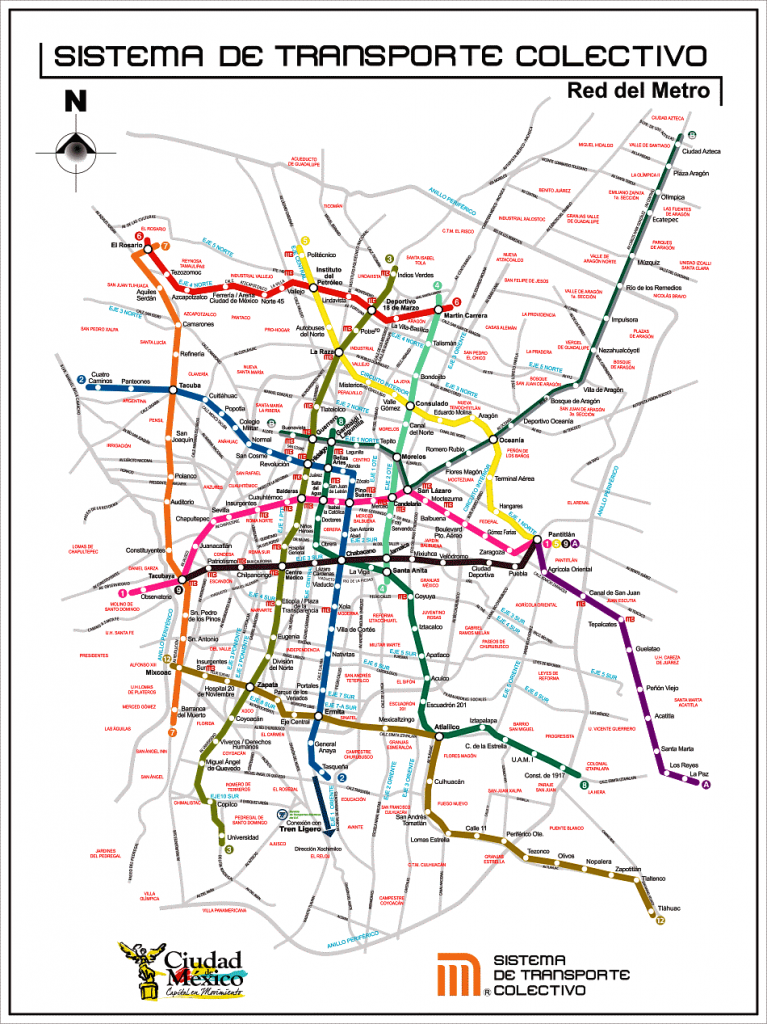 The major proposals affect three metro lines:
The major proposals affect three metro lines:
Metro Line A (Pantitlán to La Paz) will be extended 12.9 kilometers to the southeast, with six new intermediate stations, to Chalco in the state of Mexico, at a cost of about 1 billion dollars. [Update – March 2016 – officials have described the proposal to extend line A as “cancelled“]
The lengthening of Metro Line 4 (Martín Carrera to Santa Anita) northeastwards to reach Tepexpan will require investments of 1.5 billion dollars and add 19 intermediate stations as well as a terminal in Tepexpan. It will have improved links to other Metro and Metrobús lines.
Metro Line 12 will be extended northwards beyond its present terminus in Mixcoac to include new two intermediate stations and a new terminal station in Observatorio. This line will improve transit through Observatorio for passengers, including those using the future high-speed train link between Toluca and Mexico City.
Note that the elevated (above ground) southern section of Metro Line 12 between Tlahuac and Atlalilco stations, closed for repairs since March 2014, remains closed and is not expected to reopen until the second half of 2015. A replacement bus system has been established between those stations.
Useful links:
- Map of Mexico City metro system (png image file)
- Map of Mexico City metro system (official printable system map, pdf file)
Related posts:
Recycled plastic boats for Xochimilco?
What will they think of next? Officials in Mexico City have plans to provide the tourist zone of the Xochimilco canals with environmentally friendly boats and barges and to gradually substitute the usual wooden ones, which have very high maintenance costs. The plan was unveiled a few weeks ago by Mauricio León, director of infrastructure, modernization and innovation for the Federal District.
Apparently, the traditional wooden vessels, known as trajineras, with their colorful arches, formerly used mostly to transport goods but now dedicated almost exclusively to tourism, require “an enormous expense” each year since they need to be renovated annually, in part due to “the deterioration in recent years” of the water quality in the canals. According to León, the water contains high levels of fungi that degrade the wood. (Q. In that case, why not clean the water, and keep the traditional designs made of wood?)
Mexico City officials have already launched a prototype of the new, plastic, ecologically-sound craft, and hope that the owners of the traditional gondola-like non-motorized boats will form a cooperative to gradually replace them. The design of the new “technoecological” vessels was created by scientists at the National University (UNAM) and preserves the typical characteristics that have made it a widely recognized symbol of tourism in Mexico.
The great advantage of the new boats, made of recycled PET plastic (some of it no doubt pulled from the canals), polyethylene and volcanic clay is their greater durability and stability. Proponents claim that since they are made of recycled material, unlike the traditional ones for which 20 trees have to be cut down to make each trajiinera, the new boats are much cheaper, require less maintenance and their durability is much greater, with the potential to last up to 120 years.
There is one slight problem: the cost of the machinery required to make them. Authorities hope to persuade the boatmen to form “a cooperative able to get financing for the machines,” which will require an investment of some 5 million pesos ($380,000).
This is a long-term plan, because even when the machines are installed, they can produce only about three or four boats a week, and there are an estimated 1500 trajineras currently plying the canals in Xochimilco.
Related posts:
Test wells being drilled to assess Mexico City’s deep water aquifer
Pemex, Mexico’s state-owned oil giant, will start drilling the first of two deep exploratory wells in Mexico City later this month to investigate an aquifer deep below the city that is believed to hold vast quantities of potable quality water. For further background, please see our previous post on this topic:
The test wells are part of a $30 million multi-agency study now underway that incorporates experts from the Water System of Mexico City (SACM), the National Water Commission (CONAGUA), the engineering and geology departments of the National Autonomous University of Mexico (UNAM), and Pemex, which is providing the technology to drill the wells.
Later this month, Pemex will start drilling the first 2000-meter-deep test well in the Magdalena Mixhuca Sports City area, in the eastern part of Mexico City. Each well will cost an estimated $7.6 million to complete.

Schematic stratigraphy of the southern portion of the Basin of Mexico.
Source: Adapted from Mooser, 1990.
Ramón Aguirre, the CEO of SACM, says that the two test wells will target two different zones, increasing the chances of demonstrating the value of the aquifer as a viable source of water for Mexico City. In particular, Aguirre expects the wells to help confirm that there is an impermeable cap of clay separating the deep aquifer from the principal aquifer in the area (from which water is already extracted). An impermeable layer would mean that water could be safely removed from the deep aquifer without leading to downward drainage of water from the aquifer above. It is expected to take about two years for the initial studies to be completed.
In its National Water Plan, CONAGUA has warned that population growth in the Valley of Mexico could result in serious water shortages by 2030, reducing annual availability from about 4,230 cubic meters/person to less than 1,000 cubic meters/person.
The major aquifer currently used lies at a depth of between 60 and 400 meters and is heavily over-utilized. There are about 630 wells in the Federal District alone; all are overexploited and have an average life expectancy of 30 years. Current extraction from the aquifer is around 17,000 liters/second, while its natural recharge capacity is only 8000-9000 liters/second. It is believed that the deep aquifer could be capable of supplying approximately 5000 liters/second.
Related posts:
- Mexico City explores deep water aquifer (Dec 2013)
- Where does Mexico City get its water from? (May 2013)
- Mexico’s major cities confront serious water supply issues (Apr 2013)
- How fast is the ground sinking in Mexico City and what can be done? (Apr 2012)
- Mexico’s freshwater aquifers: undervalued and overexploited (Nov 2011)
- How can Mexico City find sufficient water? (May 2013)
A new airport for Mexico City
The Mexico City Benito Juárez International Airport handled 31.5 million passengers in 2013, but is operating at near capacity. To ease its congestion, the federal Communications and Transportation Secretariat (SCT) has announced plans to expand the airport eastwards, by annexing 5500 hectares of adjacent federal land bordering Lake Texcoco. The expansion will take several years to complete.
A long-term 9.2-billion-dollar master plan for the airport, with two main phases of construction, was developed by engineering consultancy Arup.
Earlier this week during his second state-of-the-nation address, President Enrique Peña Nieto announced that the winning proposal for designing the new terminal building that forms an integral part of the first phase was submitted by UK-based architect Sir Norman Foster and his Mexican associate Fernando Romero, Carlos Slim’s son-in-law, in association with Netherlands Airports Consultants.
Peña Nieto described the new airport as “the biggest infrastructure project in recent years… and one of the biggest in the world.” He emphasized that his administration was not adopting the easiest short-term path, but “choosing the responsible path”, adding that a project of this scale would inevitably extend well beyond his time in office.
He expected that the new airport would boost tourism, allow more airlines to serve Mexico City, and also help to regenerate an area that has previously suffered severe environmental degradation.
The winning design for the iconic new terminal takes the shape of an “X”, incorporates national symbols in its details, and offers ample space for airport operations, passenger services and exhibitions. The architect is confident that the new airport will be the most sustainable airport in the world, and exceed LEED platinum standards, the highest level of LEED certification.
The first stage, due to be concluded by 2020, involves construction of a new terminal building, control tower and all the infrastructure for operating two runways simultaneously, handling up to 50 million passenger movements a year. Initial work on drainage and foundations will begin later this year. The first phase will generate an estimated 50,000 direct jobs and 160,000 jobs in total.
By 2050, a second phase would have added four more runways and more than doubled the airport’s capacity to 120 million passenger movements.
Record passenger levels in Mexican airports
During the first five months of 2014, Mexico’s airports registered 26,797,688 passenger movements (about 45% international, 55% national), a new record, and 10.8% more that for the same period in 2013. Aeroméxico, the nation’s flagship carrier, accounted for 35.3% of all passenger movements in Mexico, followed by Interjet (23.4%), Volaris (23.3%) and VivaAerobus (12.5%). Aeroméxico recently added several new routes, including links from the northern industrial city of Monterrey to Aguascalientes, San Luis Potosí, Cancún, Puerto Vallarta and Los Cabos.
Related posts:
Recent progress in waste water treatment in Mexico
Two wastewater treatment plants have been in the news recently. The first is the $230 million Agua Prieta wastewater treatment plant, located north of Guadalajara in Jalisco, which was formally inaugurated last month. It is the first stage in a plan to restore the heavily polluted Santiago River back to health. The Santiago is the outflow from Lake Chapala and receives pollutants from the industrial zone of El Salto outside Guadalajara. The initial capacity of the Agua Prieta plant is 6,500 liters/second, almost all of which is returned to the river after treatment.
The plant was built by a consortium led by ICA subsidiary Conoisa, Atlatec, and Servicios de Agua Trident under a 20-year concession. President Enrique Peña Nieto claims on his government webpage that, “Integrated, sustainable water management is a government priority. The challenge is even greater because almost 50% of the wastewater returned to the environment does not undergo any form of treatment… The Agua Prieta Wastewater Treatment Plant in Zapopan… [will] improve the quality of life of 3.3 million inhabitants in the metropolitan area of Guadalajara… It will treat 82% of the wastewater in the area, and 100% when the complementary sewage works are completed.”
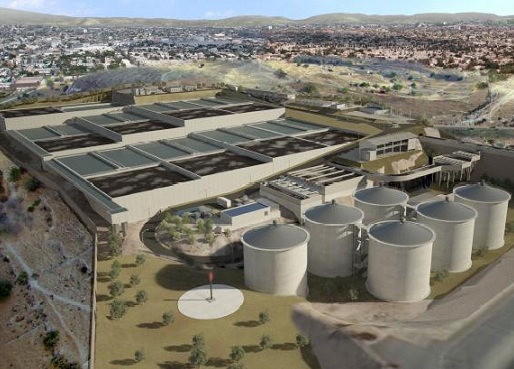 According to government figures, waste water treatment coverage at the national level is currently 50.3%, with a 2018 target of 63%. Agua Prieta has raised national coverage to 53.3%, and will boost it to 54.3% once the plant is operating at full capacity and treating 8,500 liters/second of wastewater. At the state level, Jalisco is now treating 32% of its wastewater.
According to government figures, waste water treatment coverage at the national level is currently 50.3%, with a 2018 target of 63%. Agua Prieta has raised national coverage to 53.3%, and will boost it to 54.3% once the plant is operating at full capacity and treating 8,500 liters/second of wastewater. At the state level, Jalisco is now treating 32% of its wastewater.
The Agua Prieta plant is currently the largest of its kind in Mexico and is powered by biogas derived from the wastewater sludge. However, an even larger plant is under construction, in the state of Hidalgo in central Mexico. The Atotonilco Wastewater Treatment Plant is being built by a consortium, including Mexican construction companies ICA and IDEAL, Mitsui subsidiary Atlatec and Spanish firm Acciona Agua, that won the concession to design, build, and operate this plant for 22 years, at which point the plant will be transferred to federal ownership. Work began in 2010 and is due to be completed by 2015.
The Atotonilco Wastewater Treatment Plant will be the largest wastewater plant in Latin America and one of the largest in the world, with a biological treatment capacity of 23,000 liters/second (1.99 million m3/day). The wastewater treatment is performed by a series of conventional processes, with an additional chemical process during the rainy season. Treated waters from this plant are already being used in agriculture without any additional cleaning steps. The plant is self-sufficient in terms of energy usage, since it converts the methane offgas from the wastewater sludge into electrical energy.
Related posts:
Popocatepetl Volcano continues its very active phase
Popocatepetl Volcano, near Mexico City continues to be very active, with smoke and ashes belching up to 1000 meters above the crater rim. Mexico’s National Disaster Prevention Agency Cenapred, reports that the volcano had 82 “low intensity” exhalations on 7 August 2014, four of which contained “explosive material”.
The agency also reported that many mionr tremors hd been recorded, including one harmonic tremor lasting 56 minutes. Geologists believe that the volcano is currently destroying dome number 50 even as dome number 51 begins to form. Dome #51 is currently about 70 meters in diameter. Renewed explosions, together with some ash fall is predicted for the coming days.
The Volcanic Traffic Light remains at Yellow Phase 2.
For a series of images dated 8 August 2014, see Images of 8 of ago of 2014
Related posts:
- Images of continued eruption of Popocatepetl Volcano (6 July 2013)
- Alert level rises as Popocatepetl volcano starts to erupt (April 2012)
- Update on the activity of Popocatepetl Volcano (May 2012)
- Popocatapetl Volcano and Colima Volcano continue to erupt (March 2013)
Quick photo visit to Mexico City
The many stupendous images of Mexico City in “HA!!!, And You Thought We Were Riding Donkeys” on the “Lost in My Little World” blog undoubtedly only portray one side of Mexico City (the nice side), but that does not make them any the less worth viewing.
As the blog’s author puts it, “People are always asking me what living in Mexico City is like. Most people either think its dirt, sombreros and donkeys, or they think that drug dealers and kidnapers are waiting for you to get out of your car to kill you at anytime. None of these speculations are real!! It is one of the greatest cities on earth and this article is here to prove it...”
- Images of Mexico City
Sadly, the images lack captions, though many of the places are readily identifiable if you have ever visited Mexico’s premier cultural and social center.
Looking for balance? Some of the comments below the images offer links to the many alternative, less attractive sides of the city.
Three Mexican cities among the 100 most competitive cities in the world
Three cities in Mexico – Mexico City Metropolitan Area, Monterrey Metropolitan Area and Querétaro – are included on the 2013 list of “The World’s Most Competitive Cities. A Global Investor’s Perspective on True City Competitiveness”, a report issued by Site Selection magazine in cooperation with IBM Global Business Services.
It is the first time the city of Querétaro (2010 population: 805,000) has been included on the list; Mexico City and Monterrey are old-timers on the list.
The 100 cities studied all have a minimum population of 1 million inhabitants in the local labor catchment area and attracted at least 25 foreign investment projects in 2009-2011. The study aims to rank the competitiveness of cities “to attract investment and international projects in various sectors”, and to identify those locations with the best combined “cost-quality” for particular types of investment project.
The report presents rankings and findings for five different types of operations:
- International headquarters, coordinating corporate operations in a global region
- Financial services center of competence
- Software development center
- R&D center for life sciences, combined with pilot production
- Shared services center, providing support for corporate operations in finance, customer support, human resources or IT
Rankings are based on 30 factors or parameters (see chart above).
The most competitive cities in the world were London, U.K. (score of 78.0), Singapore (78.5), New York City (77.4), Amsterdam (76.3) and Hong Kong (75.9).
Mexico City Metropolitan Area was ranked as number 57, with a score of 55.8. Monterrey Metropolitan Area ranked number 72 (48.2) and Querétaro city ranked number 90 (43.6).
Related posts:
- The geography of Mexico City: index page
- Have big cities in Mexico succeeded in meeting people’s needs? (Sep 2013)
- The most competitive states in Mexico (Dec 2010)
- Several Mexican cities rank among the American Cities of the Future (Apr 2013)
- The growth of the city of Monterrey, Mexico’s industrial powerhouse (Oct 2013)
- City of Querétaro becoming Mexico’s aeronautical manufacturing center
A major earthquake struck southern Mexico at 7:27 local time on Friday 18 April 2014. The effects of the earthquake, which had its epicenter in Guerrero, were felt at least as far away as Mexico City. Authorities in the states affected, which include Guerrero, Morelos, México, Puebla, Oaxaca, Querétaro, Veracruz, Jalisco, Michoacán, Tlaxcala, Guanajuato, Hidalgo, Colima and the Federal District, have reported only minor damage, and no loss of life.
The preliminary report from Mexico’s National Seismological Institute says that the earthquake had a magnitude of 7.0, with an epicenter 31 kilometers northwest of Tecpan in Guerrero, and occurred at 7:27 a.m. local time. The earthquake occurred at a depth of 10 kilometers.
Initial reports from the U.S. Geological Survey (including a map) are that the earthquake was 7.5 magnitude, and at a depth of around 48 kilometers (30 miles). The USGS has since downgraded the magnitude to 7.2.
First hand reports from Mexico City say that power went off in several areas in the north of the city, and that cell phone communications were also down in some areas. The Federal Electricity Commission reported 6 hours after the earthquake that power had been restored to 98% of the 1.2 million people affected in the Mexico City Metropolitan Area. Some windows have been shattered, and there are a handful of reports of minor structural damage, including 15 walls that collapsed and 48 buildings that suffered some damage. The city was quieter than normal because of the Easter holidays, during which many city dwellers take vacations at the beach.
The most serious damage in Mexico City appears to have been in the Morelos residential complex in colonia Doctores, where the residents of two of the 14-story buildings have apparently been evacuated following reports of cracks in walls and passageways, and the separation of some stairways. Following a formal building inspection, one of the buildings will not be reoccupied prior to remedial work being carried out.
Residents of Mexico City received 65 seconds warning via Mexico’s advanced Seismic Alert system (Sistema de Alerta Sísmica), which functioned precisely as it was designed to. There were more than twenty aftershocks in the five hours after the initial earthquake, the largest of which was magnitude 4.8.
George Dunn in Puerto Vallarta (see comments) reports that buildings at the Bay View Grand were evacuated. “but all is well”. Many tourists in Puerto Vallarta and Acapulco left their hotel rooms temporarily during the quake which lasted about one minute.
In Guerrero, it is reported that the highway between Acapulco and Ixtapa-Zihuatanejo is temporarily closed to traffic while inspections are carried out of a bridge near Tecpan, where the road shows a marked displacement (see image), and the rubble from several small landslides is removed. [Update: 9 May 2014: A second earthquake of magnitude 6.4 on 8 May has caused the bridge to collapse completely. The bridge, known as “El Cuajilote” is located at km 111 of the federal highway between Acapulco and Zihuatanejo.]
Later on Friday, officials of Guerrero state acknowledged that many public buildings in the state suffered damage from the earthquake. In Petatlán, near the epicenter, at least 100 homes were damaged. In the state capital of Chilpancingo, several walls collapsed, at least three homes and the tower of the Santa María de la Asunción cathedral suffered some damage.
As a precaution, the main (tourist) dock in Zihuatanejo has been closed, pending a formal inspection, but is expected to be back in operation within the next day or two.
Curious coincidence: The earthquake came exactly 108 years to the day after the Great San Francisco Earthquake of 1906.
We will continue to update this post periodically over the next few days to reflect any significant changes.
Related posts:
Passenger cable car for Mexico City
Update (20 January 2016): The 4.8-kilometer-long Mexicable cable car linking San Andrés de la Cañada (in the Sierra of Guadalupe) to Vía Morelos (in Ecatepec) should be in operation within a few weeks, according to latest press reports. The cable car will be Mexico’s first cable car system specifically aimed at public transit. Several locations in Mexico already have cable car systems designed for tourists.
The Mexicable line, which cost around $70 million to build, will have 190 10-passenger cars and be able to carry up to 6000 passengers an hour. It will reduce travel time between San Andrés de la Cañada and Vía Morelos from 45 minutes to less than 20 minutes. There are five intermediate stations in addition to the two terminals.
Original post (2014):
Work will begin shortly on building a 5-kilometer-long intraurban cable car in the Sierra de Guadalupe region of Mexico City. The cable car, formally known as “‘Teleférico Mexicable Sierra de Guadalupe” will link residents of the densely populated San Andrés de la Cañada settlement to Vía Morelos in Ecatepec.
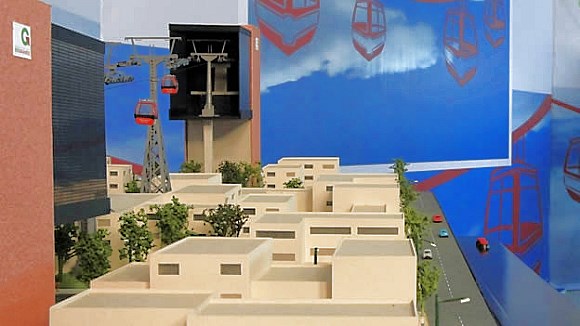 The cable car system will be similar to tried and tested cable car systems that have proved successful in Zurich (Switzerland) and Medellin (Colombia).
The cable car system will be similar to tried and tested cable car systems that have proved successful in Zurich (Switzerland) and Medellin (Colombia).
The Sierra de Guadalupe cable car will have 190 cabins and 7 stations in total, including the 2 terminals. The 95-million-dollar system will benefit up to 300,000 people, and be able to carry 6000 people an hour. It will more than halve the current travel time of 45 minutes from one terminal to the other to less than 20 minutes.
The Via Morelos terminal will be close to the existing mass transit options such as line 4 of the city’s Mexibús system and the Mexico City metro. About 300 workers will be employed during construction which is scheduled to be completed by early 2015. Once completed, the system will provide about 40 permanent jobs. The standard fare on the system is expected to be 9 pesos (about 70 cents).
A similar project is still under consideration for a western section of Mexico City, linking Santa Fe to Chapultepec.
Related posts:
- Cable cars in Mexico (May 2013)
- Will Mexico City add cable cars to its mass transit system? (Apr 2013)
- New aerial transit system proposed for Mexico City (Sep 2013)
- Traffic congestion still a serious problem for commuters in Mexico City (Sep 2011)
- Mexico City tackles the challenges of population, commuting and air quality (Aug 2012)
- Line 12, Mexico City’s latest Metro (subway) line
Plans to improve the Mexico City-Toluca transport corridor
The Mexico City Metropolitan Area (dark grey on the map), which occupies the Valley of Mexico, extends well beyond the northern boundary of the Federal District and includes many municipalities in the State of Mexico. The two administrations (the Federal District and the State of Mexico) have to work closely together in order to coordinate actions in the Metropolitan Area, which had a population in 2010 of 20.1 million.
Toluca, the capital of the State of México, is Mexico’s 4th largest urban area, and a fast-growing industrial city in its own right, with a 2010 population of 1.8 million.
Toluca’s airport (the “Licenciado Adolfo López Mateos International Airport”) is mainly used by low-cost carriers like Interjet, Volaris and Aeroméxico Connect as an alternative to using the Mexico City International Airport, which is more expensive and operating at close to capacity. Passenger traffic through Toluca airport has grown rapidly, from 145,000 passengers in 2002 to a peak of almost 4 million in 2008, before falling back to about 1 million passengers in 2012.
Not surprisingly, the Mexico City-Toluca highway is one of Mexico’s busiest major routes, linking the Federal District via Toluca (see map) to western Mexico.
In recent months, several related plans have been announced that are designed to improve the two major transportation issues in this area:
- The near saturation of Mexico City International Airport
- The very busy (and often slow) highway between Mexico City and Toluca
To ease the situation of Mexico City International Airport, the federal Communications and Transportation Secretariat (SCT) plans to expand the airport eastwards, onto 5,500 hectares of federal land. The expansion is likely to take several years to complete, and will increase flight capacity even though it will not include an additional terminal.
Meanwhile, State of Mexico authorities have authorized a second runway for the Toluca International Airport, which will significantly expand that airport’s capacity. The SCT has proposed that Toluca Airport become an alternate airport for Mexico City, with the two airports linked by high-speed trains.
The SCT has already announced that a new rail link between Toluca and Mexico City will be jointly financed by the federal government and the State of Mexico. The existing plan is for the first phase of the “Toluca-Valley of Mexico Interurban Passenger Train” to end at the Metro Observatorio station in Mexico City, but a later phase would extend this line to Mexico City Airport. This new 2.7-billion-dollar rail line, capable of carrying 300,000 passengers a day, will run from Toluca via the upscale Mexico City neighborhood of Santa Fe to Metro Observatorio, reducing the travel time between Toluca and Metro Observatorio by more than an hour to around 40 minutes, with corresponding positive environmental impacts. Construction of the new line, which will include 4 intermediate stations, is due to begin later this year, and scheduled to be completed by 2018.
A separate 115-million-dollar project is underway to reduce highway congestion between Toluca and Mexico City. To boost the road transport capacity between the two cities, a multi-lane second tier is being added to 15 kilometers of the existing Mexico City-Toluca highway, from La Marquesa to Paseo Tollocan, at the entrance to Toluca.
Related posts:
Mexico City explores deep water aquifer
Background: The Valley of Mexico is an interior basin about 9000 square km in area. The basin floor sits at an elevation of 2200 meters above sea level and is surrounded by mountains that rise up to more than 5000 meters above sea level. It receives around 700 mm of rainfall a year, with a rainy season from late May to September.
The basin was originally the site of several lakes and marshes, and much of it is underlain by lacustrine sediments up to 100 m thick, beneath which are alluvial sediments up to 500 m thick (see geological cross-section below). These sediments are interstratified with layers of volcanic basalt. Beneath the alluvial sediments are 100 m to 600 m of volcanic deposits, which form the principal Mexico City aquifer (found about 500 m to 1000 m below Mexico City).
As Mexico City has grown, and water demands have increased, this main aquifer has been greatly overexploited, leading to a drop in the level of the water table underground, accompanied by ground subsidence that has had serious consequences for Mexico City:
Feasibility study of a deep aquifer
The National Water Commission (CNA) and Mexico City Water System (SACM) are undertaking a 3-year, 23-million-dollar feasibility study to assess the potential of an aquifer that lies more than 2000 meters below Mexico City. (Our earlier, initial report about this aquifer is here). The project includes experts from Pemex, CFE and UNAM’s Institute of Geophysics.

Schematic stratigraphy of the southern portion of the Basin of Mexico.
Source: Adapted from Mooser, 1990.
Initial exploratory wells have shown that the deep aquifer’s water quality is superior to that currently derived from the overexploited shallower wells that extend to depths of around 800m.
It is hoped that the feasibility study will confirm that water from the deep aquifer could be an additional viable source of freshwater for the city. Assuming the deep aquifer is hydrologically independent of the shallower aquifers, this would not only reduce the need to pump water from the shallower aquifers, but would also avoid the ground subsidence resulting from continued shallow-water extraction. The feasibility study will assess whether or not the deep water aquifer is “fossil” water or is still being recharged from precipitation and underground throughflow. If it is being recharged, the experts will calculate its recharge rate to determine the aquifer’s maximum sustainable yield. (The maximum sustainable yield is the “additional groundwater output from the system which will cause minimal and acceptable levels of stress to the ecosystem with maximum benefits to the society and to the economy”).
The first test well is likely to be sunk in the Magdalena Mixhuca Sports City area, in the eastern part of Mexico City.
This potential deep aquifer source of freshwater could play a vital part in ensuring that future generations of Mexico City residents have a dependable and sustainable water supply.
Mexico’s consideration of utilizing deep water aquifers runs counter to the prevailing wisdom in the US where it has long been argued that deep water aquifers will be too costly to utilize for fresh water, will never be used, and are therefore more useful as a repository for waste and can be intentionally polluted.
As a result, as this Huffington Post article explains, “policy-makers often exempt these deep aquifers from clean water protections and allow energy and mining companies to inject pollutants directly into them.” The article adds that, “the U.S. Environmental Protection Agency has issued more than 1,500 permits for companies to pollute such aquifers in some of the driest regions. Frequently, the reason was that the water lies too deep to be worth protecting.”
References:
Mooser, F. 1990. “Estratigrafía y estructura del Valle de México en el subseulo de la cuenca del Valle de México y su relacíon con la Ingeniería de cimentaciones, a cinco anos del sismo”, in Revista de la Sociedad Mexicana de Mecánica de Suelos. Mexico, D.F.
For a detailed description of Mexico City’s shallower aquifer and its exploitation, see Mexico City’s Water Supply: Improving the Outlook for Sustainability (1995) (viewable online or register for a free download)
Related posts:
- Where does Mexico City get its water from? (May 2013)
- Mexico’s major cities confront serious water supply issues (Apr 2013)
- How fast is the ground sinking in Mexico City and what can be done? (Apr 2012)
- Mexico’s freshwater aquifers: undervalued and overexploited (Nov 2011)
- How can Mexico City find sufficient water? (May 2013)
Mexico City and its surrounding areas have a strict “Hoy no circula” (“Today you can’t drive” or “Day without a Car”) program. The program is intended to reduce air pollution from vehicle emissions.
The graphic shows the major rules for most vehicles. With few exceptions, these rules apply to all tourist vehicles as well as Mexican-plated vehicles.
As of November 2013, the “Hoy no circula” program applies to the Federal District and the following 18 adjoining municipalities in the State of Mexico (see map):
- Atizapán de Zaragoza
- Coacalco de Berriozabal
- Cuautitlán
- Cuautitlán Izcalli
- Chalco
- Chimalhuacan
- Chicoloapan
- Ecatepec de Morelos
- Huixquilucan
- Ixtapaluca
- La Paz
- Naucalpan de Juárez
- Nezahualcóyotl
- Nicolás Romero
- Tecámac
- Tlalnepantla de Baz
- Tultitlán
- Valle de Chalco Solidaridad
No responsibility or liability is assumed for any situation arising from the information contained within this post, which is believed to be accurate at the time of writing. For more details about the growth of Mexico City, and its urban issues and management strategies, consider buying a copy of Geo-Mexico: the geography and dynamics of modern Mexico, available from all good bookstores, as well as via amazon.com or this webpage.
